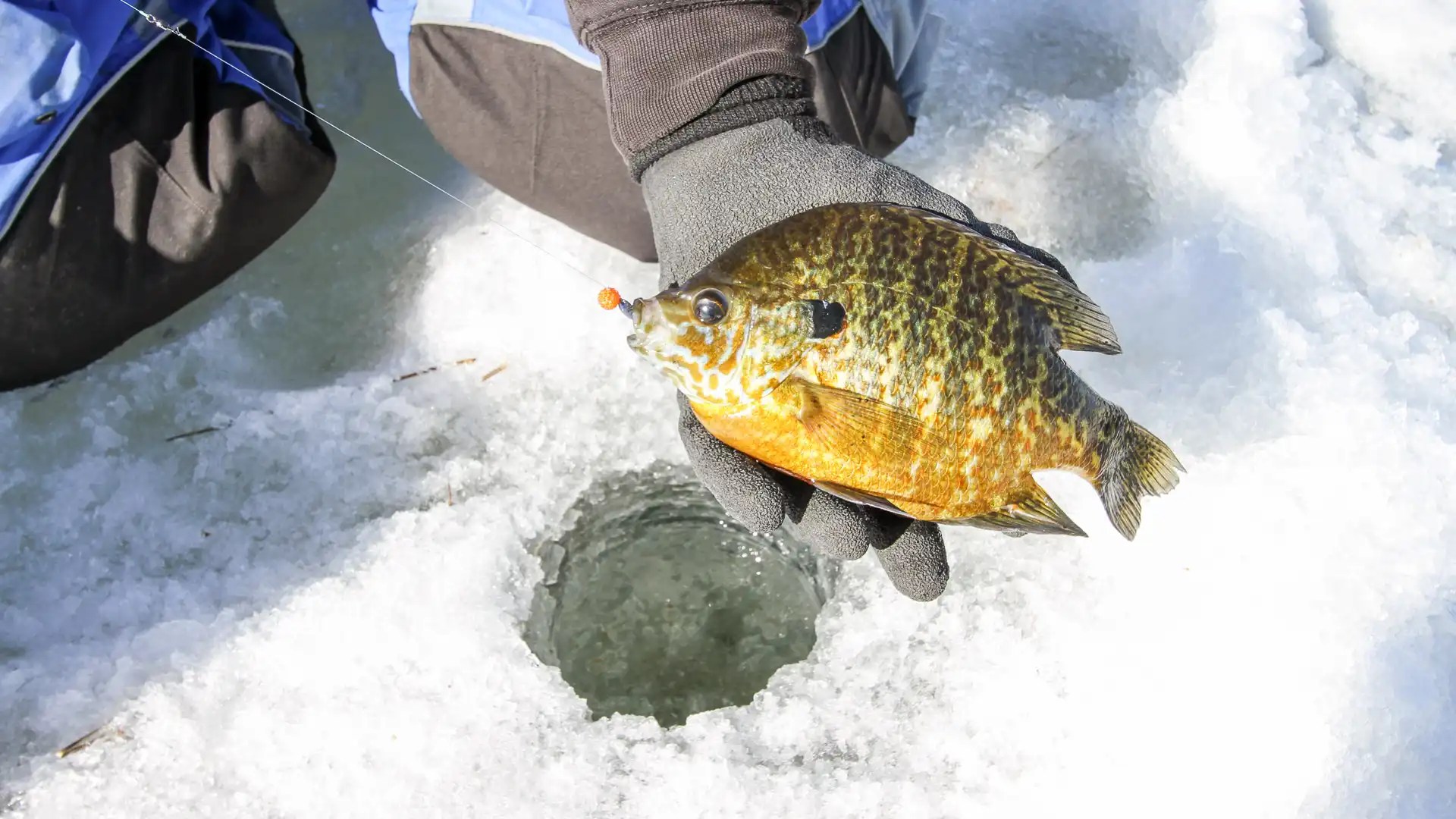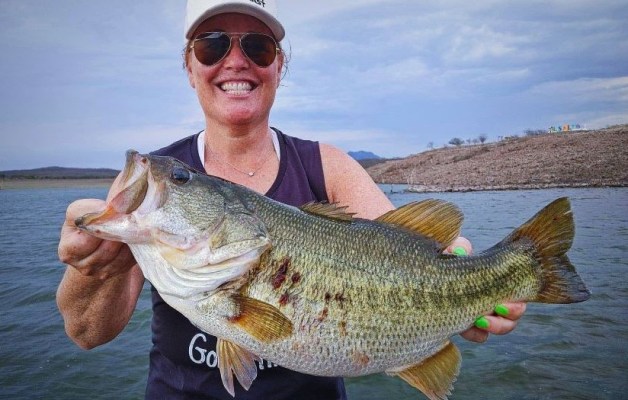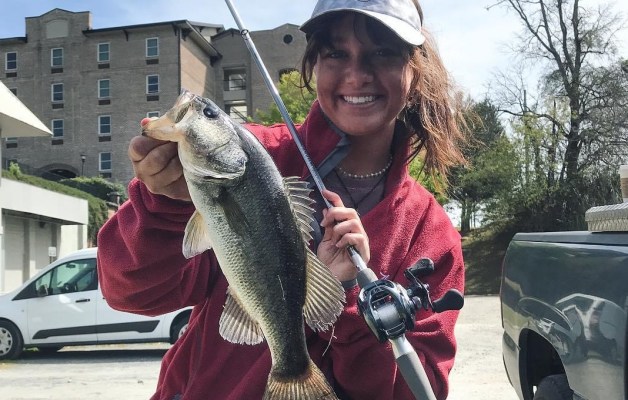
Some of nature’s greatest opportunities occur during transitional seasons. Good example: Late ice — that period in which lakes and ponds held by winter’s frigid grip move daily closer to the definitive time known as ice-out.
In latitudes where lakes and ponds freeze, late ice usually begins sometime in March, with safe conditions lasting through month’s end, sometimes into early April. Extreme or “late” winters extend the season, while milder years shorten it.

Chris Granrud, who owns and operates RainyDaze Guide Service on Minnesota’s Rainy Lake, has helped clients of all ages and abilities learn the ice fishing basics. In his view, late ice offers some of the most beginner-friendly fun of the entire hard-water season.
“No. 1, it’s just going to be more comfortable,” Granrud said of the steadily warming temperatures. “Typically, you have nicer conditions in March (and April) than you do with first ice in December. When you’re forming ice, it’s pretty cold.
“As a guide, I like it because you bring out less (gear), so it can be more of a simple sport. You don’t necessarily have to bring (pop-up shelters) and heaters. Typically, some of the snow on top of the lake is starting to melt, so you have a little nicer travel and the lake is a little more accessible.”

This is particularly relevant for beginners who may not have use of the wide-track snowmobiles, modified SUVs or various track and ski transports common to the die-hard bunch. Often, regular passenger vehicles are all you need to enjoy the late-ice fun, while small ponds offer walk-out access.
“When you get that (early) spring weather, it makes everything easier,” Granrud said. “The fish are going to be more active, and it’s just more enjoyable to be on the ice when it’s 30 to 40 degrees.”
Key changes
Rising temperatures, increasing inflow from snowmelt, plus salt accumulations transferred from winter roads by vehicle tires combine to reverse the process that hardened the water a few months prior. As Granrud explains, late ice is a time of rejuvenation.
“What happens in the (early) winter is you start to lose some oxygen in your lakes and those fish start to become lethargic,” he said. “They aren’t going to be as aggressive in the (extreme) cold, and everything is just more complicated.”

Eventually, the factors hastening ice-out also increase dissolved oxygen and ramp up the fishery’s food production. For the common ice fishing targets, that means insects, both aquatic and terrestrial, that hatch subsurface.
“The influx of new water via melt-off reoxygenates the (fishery) and then you start getting better light penetration to the bottom,” Granrud said. “We’ll do a lot of our fishing that time of year over mud bottom because there’s a lot of bug hatches. That could happen all winter long, but there’s a lot more bugs coming out of that mud (during late ice).
“All of a sudden, you have some food concentration and those fish start to get more active. I believe it’s more advantageous for them. Panfish aren’t just going to roam around with nothing to eat — they’re conserving energy. But when you have a big influx of food, then it’s advantageous for them to move around more. They’re actively feeding and there’s a better chance you’re going to catch them.”
Specifics will vary by water body, but for a general rule of thumb, Granrud said panfish typically winter in deeper, more oxygenated water and move shallower for spring. He typically finds consistency somewhere between the main basin edge and the shallow zone where the previous year’s weedbed died. As new weeds start to grow, these areas will become increasingly attractive.
Effective tactics
Ice fishing can certainly grow into a highly technical pursuit requiring advanced gear, but late-ice anglers will keep plenty busy with an array of willing and tasty panfish easily handled on simple spinning outfits and 4-pound line. Bluegill, pumpkinseeds, crappie and yellow perch top the list, and with the right presentations, it won’t take long to assemble a fresh fish dinner.

Best part about this is the bait simplicity. Granrud’s go-to: a tiny Clam Pro Tackle tungsten jig with various Maki Plastics bodies. Sweetening the package with a wax worm, Euro larvae or “spike” (blowfly larvae) can help close the deal, but angler-imparted action is essential.
“A lot of times, people just drop a (bait) down there and let it sit,” Granrud said. “You can be right on the right spot with the right fish there, but not working your bait correctly makes a big difference.
“I see it every day — people just drop the bait down and think the fish is going to come eat it. That’s not reality; the reality is that it’s a game between you and that fish, and you have to make your bait look like something that fish wants to eat.”
Sell it!
For reference, Granrud tells his anglers to consider the appearance of an aquatic insect emerging from the mud. “Is it just sitting there? Is it propelling itself around? Is it floating to the surface?

“That’s generally why we teach the slow shake. It’s not a pump-up-and-down jig stroke; that’s not what a bug does. As it’s coming out of the mud and floating up the water column, it’s propelling itself with its wings or legs. That’s what you’re trying to simulate.”
Granrud suggests holding a bait just under the surface and shaking it to see how it moves. Complement the close observation with a portable electronics pack that shows the depth and sonar returns of the fish and your lure. You can go as advanced as your budget allows — even adding an underwater camera for real-time recon — but even a basic model keeps you from fishing blind.
“You need electronics because they’re really your eyes down there,” Granrud said. “No. 1, you know how deep you are; you know if there are fish there; you know how the fish are reacting, and you know where your bait is.”
Unlike the often-visual and arm-tugging bites of open-water season, ice bites are often subtle. Even as late ice stimulates the fish, they’re still pretty cold, so a lot of the takes are nearly imperceptible. As Granrud explains, watching the action unfold enables you to make the necessary adjustments.
“Another big mistake people make is they see a fish and they want to drop a bait right in its mouth, but a fish is way too smart for that,” he said. “They realize that a minnow or an insect is always trying to get away — it’s not trying to swim into (a predator’s) mouth.
“A fish that sees something slowly moving away is oftentimes triggered. Make the fish close the gap, slowly rise up the water column, and you have a way better chance of that fish biting. Everything a fish eats is trying to get away, so you are trying to get away, yet not get away.”
Stay safe
The very process that makes late ice so productive also presents a very real safety consideration. Granrud’s advice: Enjoy the waning opportunity, but stay alert.
“Ice safety is just as important in March as it is in the beginning of the year, so you have to be careful as it starts to deteriorate,” Granrud said. “At the beginning of the year, if you get 3 to 4 inches of ice, you can walk on it. Late in the year, it can break up when you have even 10 inches of ice because the water starts filtering through all the cracks and (expanding) abandoned ice holes.

“Also, if it looks like the ice is saturated, you gotta be careful because the ice will start breaking into chunks. It doesn’t just melt to zero.”
We covered ice fishing safety in our “Chill Out” article, but Granrud notes that lakes and ponds start melting from the shoreline out. This means you could have 24 inches of good ice offshore but hazardous ice at the landing. He also recommends checking with local bait shops or seasoned anglers for the current ice status.
None of this is intended to frighten or dissuade; rather, it’s the appropriate cautionary advice to identify potential hazards — same as with skydiving, water skiing or alligator wrestling. Fun times, as long as you pay attention and remain mindful of the worrisome stuff.
Late ice is truly a race against the clock — more so, the calendar — but as long as safe conditions exist, taking every opportunity to drop something through a hole in the hard water is time well spent.





